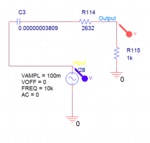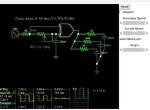Bilal_Ahm
Junior Member level 2
Hi,
My problem is to calculate the phase difference. sine wave was with frequency 10KHz and amplitude is 100mV. Resistor and capacitor are in series. Due to the capacitor there is a phase difference and that can also be seen in the simulation that i uploaded. How i can use 4046 IC or any other thing to calculate phase difference in terms of voltages that can read by the ADC of microcontroller.


red one is the output that is not in phase to the input which is blue one.
Thanks in advance.
My problem is to calculate the phase difference. sine wave was with frequency 10KHz and amplitude is 100mV. Resistor and capacitor are in series. Due to the capacitor there is a phase difference and that can also be seen in the simulation that i uploaded. How i can use 4046 IC or any other thing to calculate phase difference in terms of voltages that can read by the ADC of microcontroller.


red one is the output that is not in phase to the input which is blue one.
Thanks in advance.
